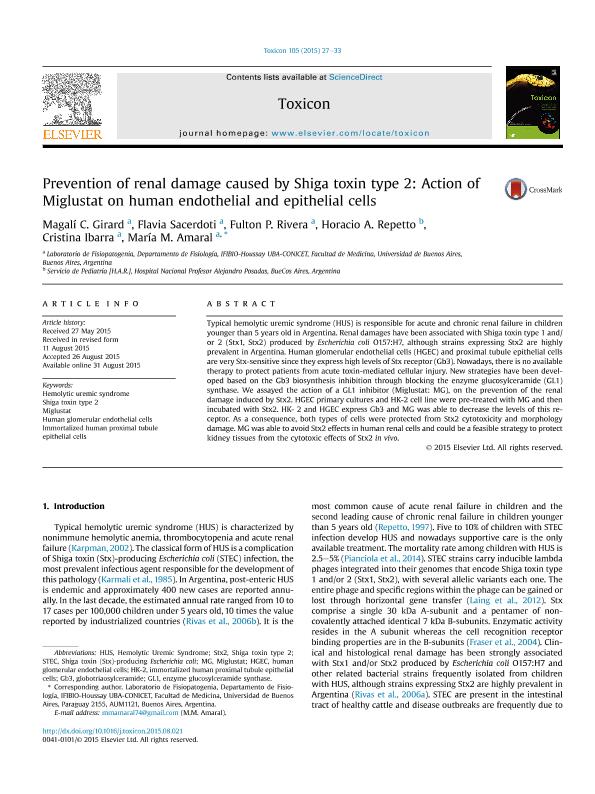Artículo
Prevention of renal damage caused by Shiga toxin type 2: Action of Miglustat on human endothelial and epithelial cells
Girard, Magalí Celeste ; Sacerdoti, Flavia
; Sacerdoti, Flavia ; Rivera Albinagorta, Fulton Paul
; Rivera Albinagorta, Fulton Paul ; Repetto, Horacio Antonio; Ibarra, Cristina Adriana
; Repetto, Horacio Antonio; Ibarra, Cristina Adriana ; Amaral, María Marta
; Amaral, María Marta
 ; Sacerdoti, Flavia
; Sacerdoti, Flavia ; Rivera Albinagorta, Fulton Paul
; Rivera Albinagorta, Fulton Paul ; Repetto, Horacio Antonio; Ibarra, Cristina Adriana
; Repetto, Horacio Antonio; Ibarra, Cristina Adriana ; Amaral, María Marta
; Amaral, María Marta
Fecha de publicación:
10/2015
Editorial:
Pergamon-Elsevier Science Ltd
Revista:
Toxicon
ISSN:
0041-0101
Idioma:
Inglés
Tipo de recurso:
Artículo publicado
Clasificación temática:
Resumen
Typical hemolytic uremic syndrome (HUS) is responsible for acute and chronic renal failure in children younger than 5 years old in Argentina. Renal damages have been associated with Shiga toxin type 1 and/or 2 (Stx1, Stx2) produced by Escherichia coli O157:H7, although strains expressing Stx2 are highly prevalent in Argentina. Human glomerular endothelial cells (HGEC) and proximal tubule epithelial cells are very Stx-sensitive since they express high levels of Stx receptor (Gb3). Nowadays, there is no available therapy to protect patients from acute toxin-mediated cellular injury. New strategies have been developed based on the Gb3 biosynthesis inhibition through blocking the enzyme glucosylceramide (GL1) synthase. We assayed the action of a GL1 inhibitor (Miglustat: MG), on the prevention of the renal damage induced by Stx2. HGEC primary cultures and HK-2 cell line were pre-treated with MG and then incubated with Stx2. HK- 2 and HGEC express Gb3 and MG was able to decrease the levels of this receptor. As a consequence, both types of cells were protected from Stx2 cytotoxicity and morphology damage. MG was able to avoid Stx2 effects in human renal cells and could be a feasible strategy to protect kidney tissues from the cytotoxic effects of Stx2 in vivo.
Archivos asociados
Licencia
Identificadores
Colecciones
Articulos(IFIBIO HOUSSAY)
Articulos de INSTITUTO DE FISIOLOGIA Y BIOFISICA BERNARDO HOUSSAY
Articulos de INSTITUTO DE FISIOLOGIA Y BIOFISICA BERNARDO HOUSSAY
Citación
Girard, Magalí Celeste; Sacerdoti, Flavia; Rivera Albinagorta, Fulton Paul; Repetto, Horacio Antonio; Ibarra, Cristina Adriana; et al.; Prevention of renal damage caused by Shiga toxin type 2: Action of Miglustat on human endothelial and epithelial cells; Pergamon-Elsevier Science Ltd; Toxicon; 105; 10-2015; 27-33
Compartir
Altmétricas



